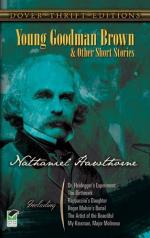|
This section contains 3,822 words (approx. 13 pages at 300 words per page) |

|
SOURCE: “Narrative Structure and Theme in ‘Young Goodman Brown,’” in Journal of Narrative Technique, Vol. 12, No. 3, Fall, 1982, pp. 221-28.
In the following essay, Hostetler discusses variant critical interpretations of Brown's experience as seen by both Brown and the narrator in “Young Goodman Brown.” Hostetler posits that Hawthorne's intersection of these two points of view illustrates “the fatal consequences of psychological misjudgment.”
One of Nathaniel Hawthorne's major themes concerns conscious awareness of the reality which the mind imposes on external objects. Hawthorne's characters are repeatedly confronted by the need to establish the relationship between their imaginations and the external world.1 Their ability to make the epistemological distinctions between the products of their mental processes and their sense impressions of the external world frequently governs their ability to develop a sound moral relationship with other people.
“Young Goodman Brown” illustrates especially well the fatal consequences of psychological misjudgment concerning perception...
|
This section contains 3,822 words (approx. 13 pages at 300 words per page) |

|


